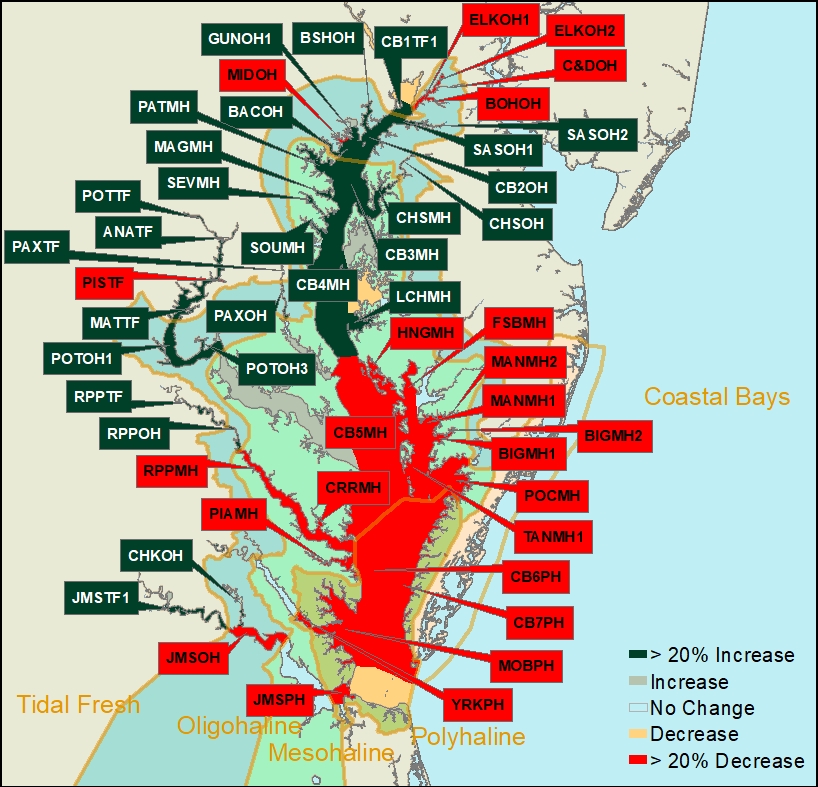2019 SAV Executive Summary
The 2019 distribution of submerged aquatic vegetation (SAV) in Chesapeake Bay and its tributaries was mapped from aerial multispectral digital imagery. These were acquired between May and September 2019, with a resolution of 24 cm, encompassing 187 flight lines. WorldView 2 satellite imagery acquired from Digital Globe through the NGA NextView program was used to augment the aerial imagery for the Belmont Bay portion of the Potomac River.
Chesapeake BayFor 2019, 26,986 hectares (66,684 acres) of SAV were mapped in Chesapeake Bay and its tributaries. SAV modestly increased in the Tidal Fresh and Oligohaline salinity zones and sharply decreased in the Mesohaline and Polyhaline salinity zones in the Chesapeake Bay. In 2019, SAV increased in 41, decreased in 28, and remained unvegetated in 24 of the 93 CBP segments.
The largest declines in terms of total area (-13,269 hectares, 32,790 ac) were observed in the Mesohaline zone particularly in the Tangier Sound area (-7,446 hectares, 18,400 ac). Losses are largely due to declines in widgeongrass which is prone to boom and bust cycles of expansion and retraction. In 2018, the Mesohaline and northern Polyhaline salinity zones widgeongrass increased and eelgrass was observed by the survey for the first time in an extensive region east of Tangier Island. The subsequent decline we observed in 2019 mirrors a similar rapid increase in widgeongrass in 2001 and 2002 that was followed by about a 50% decline in 2003. |
Tidal Fresh Bay Salinity ZoneIn the Tidal Fresh Bay Zone (19 CBP segments), 7,130 hectares (17,618 ac) of SAV were mapped for 2019. Portions of the zone, including the Mattaponi River and the portion of the Potomac River from Belmont Bay through the DC area including the Anacostia River, representing 1,124 ha of SAV in 2019 (2,777 ac, 16% of the zone total) were not mapped for 2018. Comparing the same mapped regions between 2018 and 2019, SAV increased 11% from 5,420 hectares (13,393 ac) in 2018 to 6,006 hectares (14,841 ac) in 2019.
4 of the 19 segments remained unvegetated in 2018. |
Oligohaline Bay Salinity ZoneIn the Oligohaline Bay Zone (25 CBP segments), 3,654 hectares (9,029 acres) of SAV were mapped for 2019. However, portions of the zone, including the Potomac, Bohemia, and Sassafras Rivers, representing 28 ha of SAV in 2019 (70 ac, 1% of the zone total) were not mapped for 2018. Comparing the same mapped regions between 2018 and 2019, SAV increased 13% from 3,195 hectares (7,895 ac) in 2018 to 3,626 hectares (8,959 ac) in 2019.
* Segment comparison restricted to areas mapped in both 2018 and 2019 |
Mesohaline Bay Salinity ZoneIn the Mesohaline Bay Salinity Zone (41 CBP segments), 11,356 hectares (28,061 ac) of SAV were mapped for 2019. Portions of the zone, including the north shore of the Potomac River from Herring Creek to Smith Creek, those creeks, and the St. Marys River, and portions of the Choptank and Honga Rivers, representing 608 ha of SAV in 2019 (1,503 ac, 5% of the zone total) were not mapped for 2018. Comparing the same mapped regions between 2018 and 2019, SAV decreased 55% from 24,017 hectares (59,348 ac) in 2018 to 10,748 hectares (26,558 ac) in 2019.
16 of the 41 segments remained unvegetated in 2019. |
Polyhaline Bay Salinity ZoneIn the Polyhaline Bay Zone (8 CBP segments), SAV decreased 34% from 7,362 ha (18,192 ac) in 2018 to 4,846 ha (11,975 ac) in 2019. None of the 8 segments increased by at least 20% and by at least 5 ha from 2018 totals.
1 of the 8 segments remained unvegetated in 2019. |
Delmarva Peninsula Coastal Bays ZoneIn the Delmarva Peninsula Coastal Bays Zone (10 segments covering Assawoman, Isle of Wight, Sinepuxent, Chincoteague, and Southern Virginia coastal bays), 3,358 hectares (8,297 ac) of SAV were mapped for 2019. However, the northern portion of the zone, including Chincoteague Bay and Maryland coastal bays, representing 3,641 ha of SAV in 2017 (8,996 ac, 55% of the zone total) was not mapped for 2019. Comparing the same mapped regions between 2018 and 2019, SAV decreased 7% from 3,613 hectares (8,927 ac) in 2018 to 3,358 hectares (8,297 ac) in 2019. None of the 10 segments increased or decreased by at least 20% and by at least 5 ha from 2018 totalsSix of the 10 segments remained unvegetated in 2019. |

